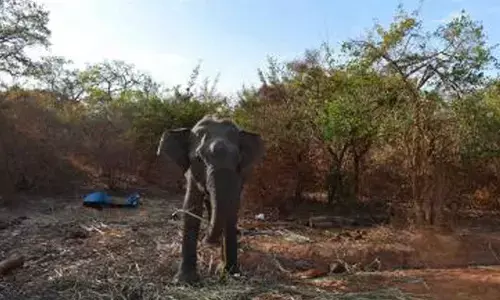Massive afforestation can reduce air pollution in Delhi

The air pollution levels in Delhi are the highest in the world today Serious concerns have been expressed by the public and by policy makers Everyone knows that for 8 months in the year, February to September, air pollution levels there are moderate and within acceptable levels PM 25 100 gm3 In this 8month period, even a small effort to improve control of emissions from vehicular t
The air pollution levels in Delhi are the highest in the world today. Serious concerns have been expressed by the public and by policy makers. Everyone knows that for 8 months in the year, February to September, air pollution levels there are “moderate” and within “acceptable” levels (PM 2.5 < 100 µg/m3). In this 8-month period, even a small effort to improve control of emissions from vehicular traffic, road suspended dust, construction activity, open burning etc would substantially alter this level.
These are due to well-known sources of air pollution. They require retro-fitment of advanced emission control technologies implemented by and integrated time-bound programme for Delhi. Retrofitment technologies include:
a.Catalytic Converter in the exhaust manifold.
b.Non-thermal plasma device as an Advanced Fuel Injection Technology.
c.Cold-start elimination technologies including electrical heaters for catalytic converters and Non-thermal plasma devices.
d.More advanced technologies may be evaluated for diesel engines: Oxygen Injection, Water Injection, Emulsified Fuels, Fuel-Borne Catalyst, Diesel Particulate filters, Wall-flow filters, Open flow filters, Urea injection and Lean NOx Traps (LNT).
However the greatest challenge there is for the remaining 4 months, October to January. Even with the very same sources and quantum of particulate air pollution, air pollution levels become extremely hazardous, peaking out at times to more than 500 µg/m3 averaging around 250 µg/m3. Even when traffic is drastically curtailed, there is negligible effect on reducing pollution levels. Why is this so?
A recent study shows that in winter months an uncharacteristic weather condition arises from a combination of low ambient air temperature and high dew point (high relative humidity at the low winter temperatures). These weather factors combine together to “condense” the constituents of air pollution,and become a terrifying concoction of dust, smoke and microscopic water droplets that amplifies the air pollution level by a factor of 7.5 i.e. by 750%. This unusual phenomenon is illustrated in the figure that sets out monthly air pollution levels in Delhi for the year 2015.
Without addressing this weather factor, all attempts to reduce vehicular emissions, road dust etc alone would be long drawn out and perhaps futile. A change of weather factors in winter months is needed to eliminate this noxious air pollutant phenomenon. It has been scientifically shown that if the ambient humidity conditions are modified during these months October to January, then Delhi will emerge one of the cleanest cities in the world.
Apart from reducing particulate air pollutants at their sources what is needed are winters with a different relative humidity that alters the delicate winter balance of ambient temperature and relative humidity.
How to eliminate air pollution in Delhi by weather change
How is the Delhi weather to be altered? The answer may well be considered as obvious: a major programme of massive afforestation outside the capital city and within the city as well!
Direct Benefits of Trees for Reducing Air Pollution. Trees reduce air pollution in many direct and indirect ways
1.Trees help settle out and trap dust and smoke from the air.
2.They improve air quality by absorbing carbon dioxide and potentially harmful gasses, such as sulfur dioxide, carbon monoxide etc from the air and provide more oxygen.
3.They lower temperature and alter humidity hence reduce trapping of particulate pollution in suspended moisture
4.An acre of trees absorb enough carbon dioxide in a year to equal the amount produced when you drive a car 26,000 miles.
Indirect benefits of trees for reducing air pollution
1.Trees conserve energy. By reducing the energy demand for cooling or heating our houses, we reduce pollution emissions from power plants.
2.Dews and frosts are less under tree because less radiant heat is lost at night.
3.Trees cause rainfall
A forest belt outside and to the south and south west of Delhi would cut down the dust levels (constituting 32 to 54% of total air pollution) in Delhi at their source while increasing air temperature as well as altering humidity as needed to eliminate the witches brew of air pollution in Delhi winters. The relationships between forests and weather are very well understood .
The exchange of sensible and latent heat, moisture, momentum and carbon dioxide with the atmosphere are the key processes by which forests can modify weather and climate. The low albedo of forests means they absorb most of the incoming solar radiation and become warmer, and then warm the air around and above them. The energy transferred from the forests to the surrounding air is called sensible heat, and involves a change of temperature.
Forests also absorb water from soils via their roots and release it into the atmosphere, a process called evapotranspiration, which has several effects on weather and climate The water vapour released can be transported to higher altitudes where temperatures are cooler, and condense to form clouds and rain. Clouds have high albedos, and so reflect incoming solar energy and cool the surface below them.
Another mechanism by which forests can affect local weather is via aerodynamic roughness. Surfaces which are aerodynamically rough increase air turbulence above them, which causes a drag on the air flowing over them and reduces the wind speed. Surfaces which have low aerodynamic roughness include ice, grasses and crops.
The surface of forests, however, is aerodynamically rough, which causes turbulence in the air and enhances the exchange of sensible heat and moisture from the forest into the air. The moisture content of air above the forest becomes larger, which could cause convection, cloud formation and an enhancement of rainfall. Trees sway in the wind which further acts to slow down the wind speed and increase turbulence. Overall, momentum has been transferred from the air to the forests.
It is this aerodynamic drag of the surface of the forest that traps dust laden winds. Delhi has historically been a recipient of dust-laden winds and storms blowing across loose soil on 91,000 sq. Km of alluvial plains mostly now in Pakistan, and also from the deserts of Rajasthan. A deep wooded forest belt around Delhi could help drastically and permanently reduce chronic air pollution in the city due to dust.
This forest belt would absorb the dust from the winds in south and south-west of Delhi, and concurrently modify the weather in and around Delhi in such a manner that would eliminate the amplification of air pollution in Delhi during the deadly winter months that are dreaded by the citizens of Delhi and looked on with horror by the rest of the civilized world.
- R Gopalaswami















